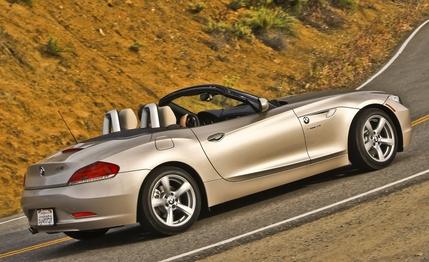 First Drive Review
First Drive Review
You don’t have to twist our arms far to get us to write about roadsters, particularly those of German descent. This explains why we have composed three separate drive stories since March on the slick new 2009 BMW Z4. All of that coverage, however, focused on the flagship Z4 sDrive35i, whose 300-hp, twin-turbocharged six-cylinder makes it the most powerful Z4 not to wear an M badge. However, it does have an M-like price. At $52,475 to start, and knocking on the door of $70,000 fully loaded, the 2009 Z4 sDrive35i is startlingly expensive.
Enter the Z4 sDrive30i, the so-called entry-level Z4, which lacks the turbocharged punch of the sDrive35i but is virtually identical in most other respects, including the chic sheetmetal, two-piece retractable hardtop, high-brow luxury accouterments, and basic chassis tuning. Furthermore, it gets better fuel economy and starts at $46,575. So the $5900 question was: Would we miss the turbos when they were gone?
We admit we were not overly optimistic about the cheaper Z4, since our sDrive35i experiences taught us to expect curious body motions, spiritless electric steering, and most egregious of all, a very un-BMW sense of disconnection between driver and road due to the seats being situated less than a foot ahead of the rear axle. And with more than 200 extra pounds to lug around compared with the previous model, thanks to the new retractable hardtop and its supporting structures, the Z4 sDrive30i had some sports-car mettle to prove.
Every Car Should Have a Base Engine This Good
The little roadster certainly has the right stuff under the hood. As far as “base” engines go, they don’t get any better than BMW’s prolific, free-breathing 3.0-liter inline-six that pumps out 255 hp and 220 lb-ft of torque. It’s the same basic engine found under the hoods of many much-heavier Bimmers, including the 1800-pound-meatier X5. But the Z4 represents a particularly intimate setting for it, allowing the driver to savor the linear crescendo of power as the revs climb, accompanied by the engine’s distinct buzz-saw rrrriiiiiiiiip that sounds especially strident from the helm, thanks to the proximity to the exhaust tips.
Of course, the Z4 is quicker with the turbos—we hit 60 mph in 4.8 seconds in each of our sDrive35i testers—but with slightly less weight to move, the sDrive30i roadster still can gather speed right swiftly. BMW’s estimated 0-to-60-mph times of 5.6 seconds with the stick and 6.0 with the six-speed automatic seem entirely believable, if not a touch conservative. Top speed is governed to 130 mph, which is raised to 150 with the optional Sport package. Meanwhile, at saner speeds, fuel economy is excellent, with the sDrive30i expected to achieve 19 mpg in the city and at least 28 mpg on the highway.
We found happiness with the manual transmission, which is blessed with BMW’s trademark snickety-snick operation. The optional six-speed traditional automatic ($1325) is a suitably sporty match for the engine. Shifts range from imperceptibly relaxed in drive mode to assertive and snappy in sport and manual modes, complete with rev-matched manual downshifts. Indeed, the only way BMW could improve the automatic transmission would be to replace it with the seven-speed dual-clutch gearbox offered—for just $1525—on the sDrive35i.
Adaptive Suspension versus Imaginary Body Roll
We also sampled the optional Sport package, which includes 18-inch wheels, sport seats, and BMW’s nifty “Adaptive M Suspension,” with normal, sport, and sport plus settings. Left in its default mode, the Z4’s chassis absorbs impacts gracefully, although perhaps too thoroughly to allow meaningful communication between road and driver. Leave it there when the curves tighten up, and get ready to watch the Z4’s bobbing nose hurtle and lift from side to side, with the suspension allowing the inside wheels to stretch into yogalike extensions.
Selecting sport tells the Z4 to get serious, firming up the adjustable shocks, dialing up throttle response, adjusting the level of electric steering assist, relaxing the stability-control parameters—and, on automatic-equipped Z4s—quickening shifts and raising shift points. The sport plus setting presents the sharpest and most nanny-free mode, although we didn’t notice such an improvement in body control that the uncomfortably calcified ride quality was offset.
Comfort à la Carte
As the weekdays passed and we grew accustomed to the unusual dynamics, our appreciation for the newfound space and comfort inside the Z4 grew. With the exception of cabin upholstery (the 30i gets leatherette whereas the 35i gets “Kansas” leather), the standard and optional equipment lists are virtually identical between base and uplevel Z4s. As is typical of BMW, the Z4 comes standard with just enough trimmings to make occupants as comfortable as they’d be in, say, a Volkswagen Passat. To approach true luxury, though, one should budget for extras.
And that would still cost significantly less than a similarly outfitted Porsche Boxster, which would certainly drive better but wouldn’t be able to touch the Z4’s combination of all-weather security and genuine sense of occasion. People are taken aback when they find out that the elegant roadster they’re ogling is a Z4, and more than one person we showed it to mistook it for the legendary Z8, which is by no means an insult. And although we have yet to warm up to its handling behavior, the Z4 has an engine that makes us tingle and styling that makes us proud. Even in base form.